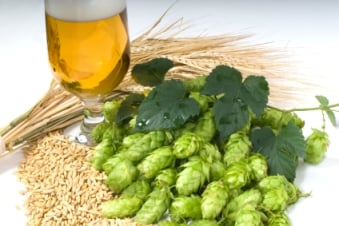
This week I take a look at methods for doing sensory analysis of hops as well as some of the resources available to understand hop flavor and aroma better.
Understanding Hop Flavor and Aroma
For a few years now I’ve been doing presentations on beer recipe design where I encourage brewers to get more familiar with the flavors and aromas that come from individual ingredients. Hope of course have played a leading role in the US craft beer and IPA revolution, and are very important to the modern brewer, so we’re going to focus on some of the ways you can get to know your hops better today.
A good starting point is actually the hop suppliers. Many suppliers like Hopsteiner, Yakima Chief, Haas and many others publish detailed specs on their hops. Some, like Hopsteiner also publish aroma “spider charts” which show the aroma profile of the hops in a visual way.

The sample above from Hopsteiner gives you a good idea of some of the aromas you can expect from hops: Citrusy, fruity, floral, herbal, spicy, resinous, sugar-like and other. Some other hop charts I pulled also included these aromas: menthol, berry/currant, green fruit, sweet fruit, caramel/cream, vegetal and green-grassy.
I found some of the charts from Haas interesting (sample here), as they publish a spider chart showing both the hops profile and also the finished beer profile based on a sample beer. Obviously the hops profile does change during boiling, fermentation and aging, but many of the beer profiles do track well with the dry hop aroma profile.
The Dry Rub Method
To get some hands on experience with hop varieties, the best method is to purchase some fresh hops and do a dry rub. Having had the opportunity to brew with several professional brewers, this is the method that they use to evaluate hops for freshness and aroma.
To perform a dry rub, open your package of hops and place them on a clean surface. Use a spoon to crush the hop pellets into a fine powder. Take a pinch of the powder and rub it vigorously between your palms. Then open your hands and get your nose down deep into the hops to sample the fresh aroma.
If you try this experiment with 5-6 different packets of hops you will quickly be able to detect which hops are the fresh “popping” ones and which ones are the “stinkers”. You can also get a very good idea of the aroma profile for the variety as each hop will have a distinct aroma profile. Try to pick out individual aromas as you sample each one.
Keep in mind that just because one packet of hops smells old or stale that may not reflect the variety as a whole. Sometimes hops get harvested at the wrong time, are processed incorrectly, or stored or packaged improperly. It may have been a bad year for that variety or grower.
This exercise will reinforce the importance of sampling the hops you are brewing with before you brew! I know many brewers who just cut their hop packets open at the appropriate point in the boil without ever sampling them – and in many cases are adding poor quality hops to otherwise great beer. Open your hop packet before you brew and do a dry rub to make sure they have a good aroma profile before you fire up the mash tun or kettle.
Hop Teas and Brewing
There is also another method for evaluating hops which involves making a hop tea with hot water and hops. While it can be an effective method I don’t see it used much anymore in part because the very bitter teas can overwhelm some of the subtle aromas you would otherwise get from the hops.
Obviously brewing beer is the best way to evaluate your hops and I encourage you to take a few notes when you do your dry rub before brewing and then compare those notes to the flavor and aroma profile of the finished beer after you brew. Doing this on a regular basis will help you develop a better sense of the flavors and aroma that come from hops and differentiate them from flavors provided by other ingredients.
Thanks for joining me on the BeerSmith Home Brewing Blog. Be sure to sign up for my newsletter or my podcast (also on itunes…and youtube) for more great tips on homebrewing.